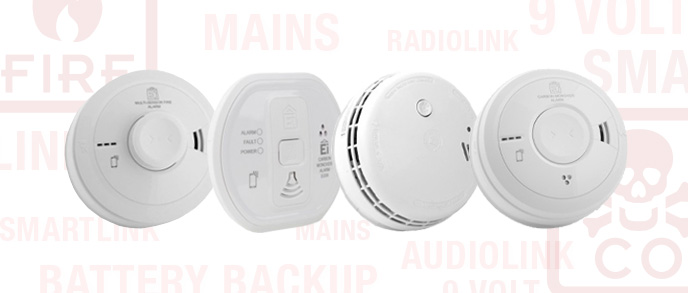
Why Do You Need a Smoke Alarm?
A house can go up in flames in less than 4 minutes, but a smoke alarm provides that life saving first warning, allowing you to get out in time and call the fire brigade. There are approximately 590,000 house fires in the UK each year, and you are 4x more likely to survive if you have a working smoke alarm.
What are the Different Types of Smoke Alarm and Which Rooms Should They be Installed in?
There are three different types of smoke and heat alarms, all carefully designed for use in specific rooms in the house, and to detect the types of smoke and fires that commonly start in those rooms. Ideally, your house should have a combination of all of the alarms listed below.
#1: Optical Smoke Alarms
Optical smoke detectors use infrared beams and photosensors to “see” smoke particles because they block the beam, which activates the alarm.
Pros: Optical smoke alarms are ideal for detecting slow burning, smouldering fires, and are less likely to be set off by everyday cooking when placed near a kitchen.
Cons: Less sensitive to fast burning fires that don’t produce a lot of smoke, and are often more expensive than ionisation smoke alarms.
Placement: Optical smoke alarms are best suited for use in hallways, landings, living rooms, and separate dining rooms.
#2: Ionisation Smoke Alarms
Previously Ionisation smoke detectors were the market leaders, however due to regulation changes brought which passed through government in December 2020 their usage has been phased out. Ionisation Smoke Detectors have not been banned from use, but other forms of smoke detectors are being strongly favoured. Ionisation alarms utilise a harmless radioactive element to create a small electrical current. This current will get disrupted if any smoke particles enter the chamber, setting off the alarm.
Pros: Ionisation smoke alarms are perfect for detecting fast burning fires with smaller smoke particles, and are often the cheapest to buy.
Cons: Less sensitive to slower burning fires, and can often be accidentally set off by cooking or smoking.
Placement: Ionisation smoke alarms are best suited for fitting in bedrooms and lofts.
#3: Heat Alarms
Heat detectors use a highly accurate thermostat to constantly monitor the temperature of the air in a room, when this temperature reaches 58°C the alarm is activated.
Pros: With heat detectors here is almost no chance of false alarm, so they can be used in rooms where other alarm types would constantly be set off.
Cons: They don't detect fires as quickly as optical and ionisation smoke alarms.
Placement: Heat alarms are perfect for use in kitchens and garages.
#4: Carbon Monoxide Detectors
Although this isn’t technically a smoke or heat alarm, a carbon monoxide detector is just as important to have in your home. Carbon monoxide (CO) is a colourless, odourless, and tasteless gas that is a product of burning fuels. When inhaled, carbon monoxide inhibits blood from carrying oxygen around the body, which is often fatal. CO alarms activate when they detect carbon monoxide in the air.
Pros: Carbon monoxide alarms alert you to a CO leak at levels that may cause a mild headache. There is also no chance of a false alarm because they are triggered by a chemical reaction to CO and any amount of carbon monoxide could indicate a leak.
Placement: Carbon monoxide detectors should be installed anywhere with an open fire or fuel burning appliance.
What Are Multisensor, Dual or Combined Detectors?
Although these terms are often used interchangeably, there is a subtle difference between the two; in multisensor alarms the two sensors play off each other to get more accurate readings, but combined detectors are simply two sensors operating separately inside the same device. A good example of a multisensor detector is the Aico Ei3024 optical smoke alarm and heat detector, which reduces the chance of false alarms when the alarm is placed in a kitchen, but increasing the speed that it will alert you to a fire.
Should You Get a Battery or Mains Powered Smoke Alarm?
Although both mains and battery powered alarms have their individual uses, nine times out of ten mains powered is the way to go. In the UK it is highly recommended that you have at least one smoke alarm per house is connected to the mains as they are more reliable. Mains smoke alarms run off the grid so you don’t have to worry about the battery dying, and they usually have a built-in backup battery in case of power cuts. Battery powered alarms are ideally used in places where there is little to no mains supply, such as caravans, boats, and temporary buildings.
Can You Get Smoke Alarms for People Who are Deaf or Hard of Hearing?
If you are deaf or hard of hearing, then the sound of a regular smoke alarm will generally not be enough to alert you to a fire, because of this, many companies have created alarms that will vibrate or flash as well. A good example of this is the Aico Ei128RBU relay module which can be attached onto or nearby any Aico alarm and configured to set off external devices, such as indicator lights, magnetic door handles, or strobes, when the alarm is activated. This means that both people who are hard of hearing and people who aren’t can benefit from the same fire alarm system.
Now you should have all the information you need to pick out the perfect alarms for your building, however, if you have any questions please feel free to give us a call on 0203 994 5470, drop us an email at sales@electricpoint.com or use our Contact Form.




